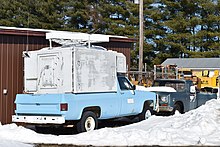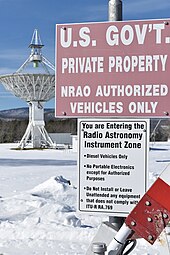United States National Radio Quiet Zone

The National Radio Quiet Zone (NRQZ) is a large area of land in the United States designated as a radio quiet zone, in which radio transmissions are restricted by law to facilitate scientific research and the gathering of military intelligence. About half of the zone is located in the Blue Ridge Mountains of west-central Virginia while the other half is in the Allegheny Mountains of east-central West Virginia; a small part of the zone is in the southernmost tip of the Maryland panhandle.
Location
[edit]The Quiet Zone is an approximate rectangle of land, 107.0 miles (172.2 km) on the north edge, 109.6 miles (176.4 km) on the south edge and 120.9 miles (194.6 km) on the east and west edges, comprising approximately 13,000 square miles (34,000 km2; 8,300,000 acres). It straddles the borders of Virginia and West Virginia, and also includes a small part of Maryland. The NRQZ is centered between the Green Bank Observatory in Green Bank, West Virginia, and Sugar Grove Station in Sugar Grove, West Virginia. It includes all land with latitudes between 37° 30′ 0.4″ N and 39° 15′ 0.4″ N, and longitudes between 78° 29′ 59.0″ W and 80° 29′ 59.2″ W.[1]
Restrictions
[edit]

Most broadcast transmitters in the central area of the Quiet Zone are required to operate at reduced power and use directional antennas. This makes cable and satellite essential for acceptable television in much of the region. Restrictions of transmissions are strictest within ten miles (16 km) of the Green Bank and Sugar Grove facilities,[4] where most omnidirectional and high-power transmissions are prohibited.
Not all radio transmissions are prohibited in the Quiet Zone. For example, emergency service (police, fire, and ambulance) radios and CB radios are permitted. However, owners of high-power transmitters, including television stations in the Harrisonburg–Staunton and Charlottesville markets, must coordinate their operations with the Green Bank Observatory. The only broadcast radio stations in the core of the Quiet Zone are part of the Allegheny Mountain Radio network, with one daytimer AM station in Frost, West Virginia, ten miles from the observatory, and low-powered FM stations in Monterey, Virginia and Marlinton, West Virginia. Exceptions to restrictions are usually determined case by case, with preference given to public safety concerns, such as for remote alarm systems, repeaters for emergency services, and NOAA Weather Radio.
The most severe restrictions to the general public are imposed within a 20-mile (32 km) radius of the Green Bank Observatory.[5] The Observatory polices the area actively for devices emitting excessive electromagnetic radiation such as microwave ovens, Wi-Fi access points, and faulty electrical equipment and asks people to stop using such equipment. It does not have enforcement power[6] (although the FCC can impose a fine of $50 on violators[7]) but will work with residents to find solutions.[8][9]
Cellular telephone use in the central area of the zone is also very restricted.[5]
"In Green Bank, though, the rules are even stronger, so much that some residents who are in direct sight of the radio telescope receivers, can't use Wi-Fi devices and even microwave ovens in all Green Bank Radio Astronomy housing units. Directional cellphone service areas are very limited, such as in Snowshoe Mountain Resort in nearby Snowshoe, West Virginia, one of the state's major ski areas."[10]
Zones of protection
[edit]
The Green Bank Interference Protection Group maintains policies to manage radio-frequency interference (RFI) by dividing into five zones based on available legal instruments.[11][12] The National Radio Quiet Zone Administrator at the Green Bank Observatory manages the enforcement policies.
Zones 1 and Zone 2 are located within the property of the Green Bank Observatory. The entire property is designated Zone 1 except small portions (such as housing, visitor, and laboratory areas) that are designated Zone 2. Zone 1, the Radio Astronomy Instrument Zone, restricts intentional radiators to those that are deemed essential. All unintentional radiators must be operated within the ITU-R RA.769 recommendations on protection criteria used for radio astronomical measurements. Gasoline-powered motor vehicles are prohibited in Zone 1 as their spark-ignition engines generate significant radio interference, resulting in the requirement that all vehicles and equipment be diesel-powered.[13] Zone 2, the Observatory Building Zone, allows intentional radiators licensed by the National Radio Quiet Zone but not other radiators such as Wi-Fi, cordless phones, and other wireless equipment. Certain types of unintentional radiators are allowed. Digital cameras are prohibited, although film photography is allowed.[14]
Zone 3 and Zone 4 are governed by the Radio Astronomy Zoning Act, Chapter 37A of the West Virginia Code. It strictly regulates radio transmitters within ten miles (16 km) of the Green Bank Observatory. Zone 3, the area within two miles (3.2 km), has the greatest restriction; it is surrounded by Zone 4, in which progressively greater emissions are allowed at greater distances.[4] Within these zones, interference to observations are identified and documented. The owners of the offending equipment are visited personally to request cooperation in eliminating the interference. Enforcement is used as a last resort. Enforcement in Zone 4 may be more lenient than the limit set by Chapter 37A.
Zone 5 is the outermost part of the National Radio Quiet Zone.
Uses
[edit]The Federal Communications Commission (FCC) created the Quiet Zone in 1958 to protect the radio telescopes at Green Bank and Sugar Grove from harmful interference.[15] Today, the Green Bank Observatory oversees the Quiet Zone.
The Quiet Zone also protects the antennas and receivers of the U.S. Navy's Information Operations Command (NIOC) at Sugar Grove. The NIOC is the location of electronic intelligence-gathering systems and is today said to be a key station in the ECHELON system operated by the National Security Agency (NSA).[16]
The area has also attracted people who believe they suffer from electromagnetic hypersensitivity,[17][18][14] though scientific experiments have shown this condition is caused by the nocebo effect rather than electromagnetic waves.[19][20][21]
Counties inside the NRQZ
[edit]Maryland counties
[edit]- Extreme southern Garrett
Virginia counties
[edit]- See also List of radio stations in Virginia, which includes several AM and FM stations within the zone.
- Western Albemarle
- Alleghany
- Amherst, except for the southern quarter
- Extreme northern Appomattox
- Augusta
- Bath
- Extreme northern Bedford
- Northern Botetourt
- Northwestern Buckingham
- Northern Craig
- Western Greene
- Highland
- Nelson
- Western Page
- Rockbridge
- Rockingham, except for a small area in the extreme eastern part
- Western Shenandoah
West Virginia counties
[edit]- See also List of radio stations in West Virginia, which includes several AM and FM stations within the zone.
- Barbour, except for a small area in the north
- Extreme eastern Braxton
- Grant, except for an area in the north
- Eastern Greenbrier
- Southwestern Hampshire
- Hardy
- Southeastern Harrison
- Eastern Lewis
- Extreme southern Mineral
- Northeastern and east central Monroe
- Extreme eastern Nicholas
- Pendleton
- Pocahontas
- Two areas in extreme southwestern and southeastern Preston
- Randolph
- Extreme southern Taylor
- Tucker, except for an area in the extreme northern part
- Upshur
- Central and eastern Webster
Cities inside the NRQZ
[edit]Virginia cities
[edit]- Buena Vista
- The western half of Charlottesville, including much of the University of Virginia grounds
- Covington
- Harrisonburg
- Lexington
- Staunton
- Waynesboro
West Virginia cities
[edit]Outside
[edit]Clarksburg, West Virginia, and Lynchburg, Virginia, are just outside the Quiet Zone.
See also
[edit]- Electromagnetic interference
- Radio silence
- Cone of Silence, a fictional device from the 1960s American television series Get Smart
References
[edit]- ^ "National Radio Quiet Zone". National Radio Astronomy Observatory. Retrieved February 20, 2015.
- ^ Casto, James E. (July 9, 2014). "NRAO Vehicle Fleet". The State Journal. Retrieved October 31, 2016.
- ^ Bucktin, Christopher (July 28, 2015). "Telescope Town can hear to within second of the Big Bang but won't let locals use mobiles". Mirror. Retrieved October 31, 2016.
- ^ a b "West Virginia Code, Chapter 37A". Chuck Niday – National Radio Astronomy Observatory. Retrieved October 8, 2013.
- ^ a b Hu, Elise (October 8, 2013). "Enter The Quiet Zone: Where Cell Service, Wi-Fi Are Banned". National Public Radio. Retrieved October 8, 2013.
To keep the zone protected from signals that could confuse the telescope, Niday and others from the NRAO drive the 20-mile radius around the Green Bank Telescope weekly, policing for possible interference.
- ^ Holba, Emile; Hall, Sara Jane (May 19, 2015). "The Quiet Zone: Where mobile phones are banned". BBC. Retrieved July 14, 2016.
- ^ "West Virginia Code, Chapter 37A". National Radio Astronomy Observatory. Retrieved July 14, 2016.
- ^ Sizemore, Wes; Acree, Jeff. "The National Radio Quiet Zone" (PDF). NRAO. Retrieved July 14, 2016.
NRAO operates the National Radio Quiet Zone at Green Bank. We briefly outline its salient characteristics, and our experience with its day to day operation.
- ^ ""National Radio Quiet Zone"... (Parkersburg, Elkins: construction, living, zip code) – West Virginia (WV) – City-Data Forum". city-data.com. Retrieved July 14, 2016.
- ^ Sterman, Joce (June 26, 2016). "'Full Measure': The No-Fi zone". WGME. Retrieved April 21, 2017.
- ^ Beaudet, C.; Clark, C.; Niday, C.; Ghigo, F.; Ford, J.; McCullough, R.; Sizemore, W.; Woody, P. (January 24, 2007). The Green Bank Interference Protection Group: Policies for RFI Management (PDF) (Report).
- ^ "NRAO Green Bank Policies for RFI Management". Retrieved October 31, 2016.
- ^ "NRAO Green Bank Site RFI Regulations for Visitors" (PDF). National Radio Astronomy Observatory. p. 2. Retrieved October 14, 2016.
- ^ a b Winter, Damon; Kennedy, Pagan (June 21, 2019). "Opinion | The Land Where the Internet Ends". The New York Times. Retrieved April 16, 2021.
- ^ "National Radio Quiet Zone – National Radio Astronomy Observatory".
- ^ "Interception Capabilities 2000, Sugar Grove, Virginia – COMSAT interception at ECHELON site". Interception of Communications Section. Leeds, UK: Cyber-Rights & Cyber-Liberties (UK). May 11, 1999. Archived from the original on September 28, 2011. Retrieved September 14, 2011.
Interception Capabilities 2000 Report to the Director General for Research of the European Parliament (Scientific and Technical Options Assessment programme office) on the development of surveillance technology and risk of abuse of economic information.
{{cite web}}: CS1 maint: bot: original URL status unknown (link) - ^ O'Brien, Jane; Danzico, Matt (September 12, 2011). "'Wi-fi refugees' shelter in West Virginia mountains". BBC News. Retrieved September 13, 2011.
- ^ "The town that banned Wi-Fi". The Guardian. Retrieved June 21, 2015.
- ^ Regel, Sabine J.; Negovetic, Sonja; R, öösli Martin; Berdi, ñas Veronica; Schuderer, Jürgen; Huss, Anke; Lott, Urs; Kuster, Niels; Achermann, Peter (August 1, 2006). "UMTS Base Station-like Exposure, Well-Being, and Cognitive Performance". Environmental Health Perspectives. 114 (8): 1270–1275. doi:10.1289/ehp.8934. PMC 1552030. PMID 16882538.
- ^ Rubin, G. James; Hahn, Gareth; Everitt, Brian S.; Cleare, Anthony J.; Wessely, Simon (April 13, 2006). "Are some people sensitive to mobile phone signals? Within participants double blind randomised provocation study". BMJ. 332 (7546): 886–891. doi:10.1136/bmj.38765.519850.55. ISSN 0959-8138. PMC 1440612. PMID 16520326.
- ^ Wilén, Jonna; Johansson, Amanda; Kalezic, Nebojsa; Lyskov, Eugene; Sandström, Monica (2006). "Psychophysiological tests and provocation of subjects with mobile phone related symptoms". Bioelectromagnetics. 27 (3): 204–214. doi:10.1002/bem.20195. ISSN 1521-186X. PMID 16304699. S2CID 39662872.
External links
[edit]- "National Radio Quiet Zone". National Radio Astronomy Observatory. Retrieved February 20, 2023. – Official website
- "The Town Without Wi‑Fi" – Washingtonian (January 2015)
- "The Town Where Wi-Fi Is Banned: The Green Bank Telescope and the Quiet Zone" – YouTube (October 2016)
- United States communications regulation
- Communications in West Virginia
- Electromagnetic compatibility
- Mass media in West Virginia
- Radio regulations
- 1958 establishments in West Virginia
- Communications in Virginia
- Mass media in Virginia
- 1958 establishments in Virginia
- 1958 establishments in Maryland
- Communications in Maryland
- Mass media in Maryland
- Garrett County, Maryland
- Federal Communications Commission
- Radio astronomy
